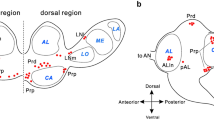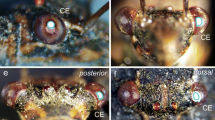Abstract.
Central nervous system ganglia within the head of the beetle Pachymorpha sexguttata were labeled using an antibody that recognizes an evolutionarily conserved region of the period (per) gene product of Drosophila melanogaster. per and the protein it encodes (PER) are believed to play a central role in the generation of endogenous circadian rhythms in flies; therefore anti-PER-mediated immunoreactivity may help to uncover cellular components of the circadian clock system in that insect and in others. In the beetle, application of this antibody led to the staining of a distinct set of neurons located in the optic lobes and the central brain, plus small numbers of putative glial cells in the optic lobes. Neuronal perikarya (including their nuclei in a few cases), the axons, and terminal regions of the neurons were stained. The network formed by these labeled cells and processes are candidates for the neuronal basis of the beetle’s circadian clock system: the pacemaker region situated next to the medulla neuropil, its connection to the apparent site of Zeitgeber input, and putative efferent pathways projecting to control centers of various effector systems. Anti-PER-mediated labeling and that resulting from application to beetle specimens of an antiserum against pigment-dispersing hormone (PDH) were compared; in the Drosophila brain all ’’PDH cells’’ express the per gene as well. In the beetle, however, the set of ’’PER cells’’ and PDH ones is at least in part nonoverlapping. The hypothesis that neurons stained by application of anti-PER participate in the control of the beetle’s circadian rhythms is discussed in the context of previous electrophysiological and immunohistochemical studies. Also considered are analogies to, and differences from, labeling of the PER protein in fruit flies and PER-like immunoreactivity in other animals.
Similar content being viewed by others
Author information
Authors and Affiliations
Additional information
Received: 4 April 1996 / Accepted: May 10, 1996
Rights and permissions
About this article
Cite this article
Frisch, B., Fleissner, G., Fleissner, G. et al. Staining in the brain of Pachymorpha sexguttata mediated by an antibody against a Drosophila clock-gene product: labeling of cells with possible importance for the beetle’s circadian rhythms. Cell Tissue Res 286, 411–429 (1996). https://doi.org/10.1007/s004410050711
Issue Date:
DOI: https://doi.org/10.1007/s004410050711




